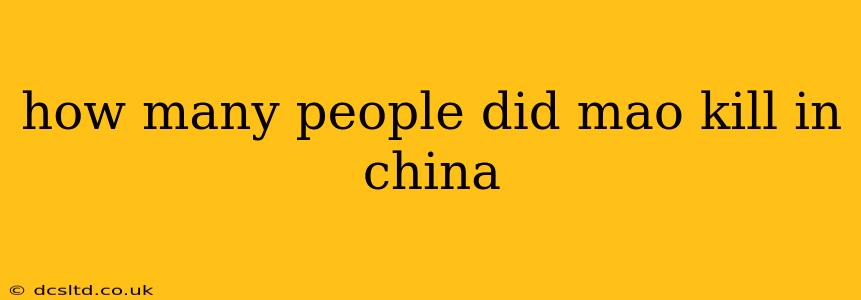How Many People Did Mao Kill in China? Unraveling a Complex and Contentious Question
The question of how many people died under Mao Zedong's rule in China is incredibly complex and deeply contentious. There's no single, universally accepted figure, and estimates vary wildly depending on the methodology used and the events included. What's clear, however, is that the death toll under Mao's regime was extraordinarily high, resulting from policies that led to widespread famine, political purges, and societal upheaval.
While pinpointing an exact number is impossible, understanding the various contributing factors to the immense loss of life is crucial for grasping the true scale of the tragedy.
What were the main causes of death under Mao's rule?
Several factors contributed to the massive death toll during Mao's leadership (1949-1976). These include:
-
The Great Leap Forward (1958-1962): This disastrous economic and social campaign aimed to rapidly transform China into a communist agrarian and industrial powerhouse. It resulted in widespread famine due to disastrous agricultural policies, leading to the deaths of tens of millions. Estimates range from 15 to 55 million, with many scholars placing the figure closer to the higher end of this range. The famine was exacerbated by the collectivization of agriculture, which disrupted traditional farming practices and led to severe food shortages.
-
The Cultural Revolution (1966-1976): This decade-long socio-political movement aimed to purge perceived capitalist and traditional elements from Chinese society. It unleashed widespread violence, persecution, and social chaos. While exact numbers are difficult to ascertain, millions perished due to execution, torture, forced labor, and starvation resulting from the disruption of societal norms and economic activity.
-
Political Purges and Executions: Throughout his reign, Mao orchestrated numerous political campaigns resulting in the imprisonment, torture, and execution of millions of people deemed enemies of the state. These victims included intellectuals, landowners, political opponents, and anyone perceived as a threat to his power.
What are the different estimates of the death toll?
Estimates of the total number of deaths under Mao's rule range dramatically, from tens of millions to over 70 million. The discrepancies stem from different methodologies, inclusion or exclusion of specific events (like deaths due to disease exacerbated by famine), and the difficulty of obtaining reliable data from a period marked by intense secrecy and propaganda.
Some scholars focus primarily on the Great Leap Forward famine, while others incorporate deaths from other policies and events. The lack of transparency and access to complete historical records further complicates accurate estimation.
How does the death toll compare to other historical events?
The death toll under Mao's rule is comparable to, or even surpasses, some of history's deadliest events. The sheer scale of suffering and loss of life makes it a significant and deeply troubling chapter in 20th-century history.
Why is there such controversy surrounding the death toll?
The controversy surrounding the death toll is multifaceted. It is intertwined with:
-
Political sensitivities: Discussions about Mao's legacy remain highly sensitive in China, with any critical assessment often viewed as a challenge to the official narrative.
-
Data scarcity and unreliability: Accessing accurate and complete data from that period is extremely challenging due to censorship and the destruction of records.
-
Differing interpretations of historical events: Historians and scholars often disagree on the interpretation of events and their causal relationship to the resulting deaths.
Conclusion:
While a precise figure remains elusive, the evidence overwhelmingly points to an extraordinarily high death toll resulting from Mao Zedong's policies. Understanding the complexities of this historical tragedy requires acknowledging the diverse contributing factors and the ongoing challenges in accessing and interpreting historical data. The sheer scale of human suffering underlines the importance of critically examining totalitarian regimes and their devastating consequences.
